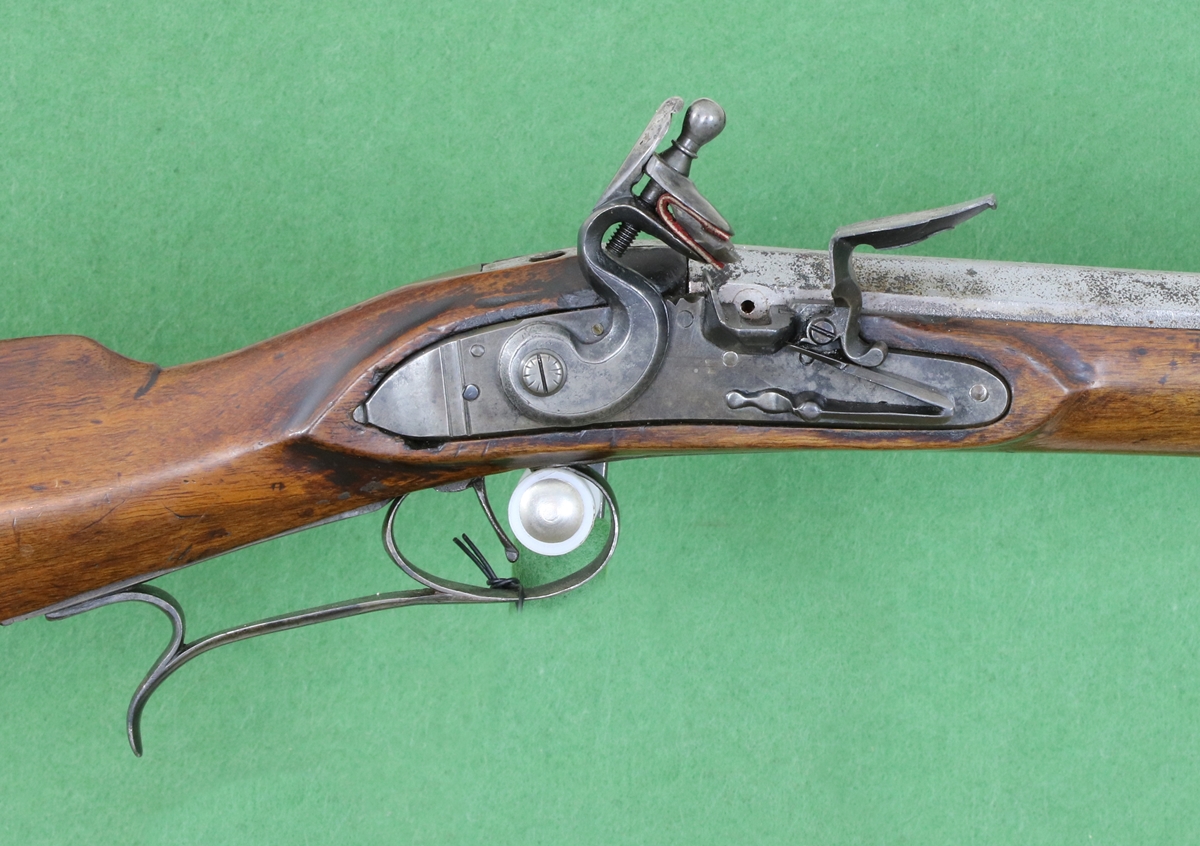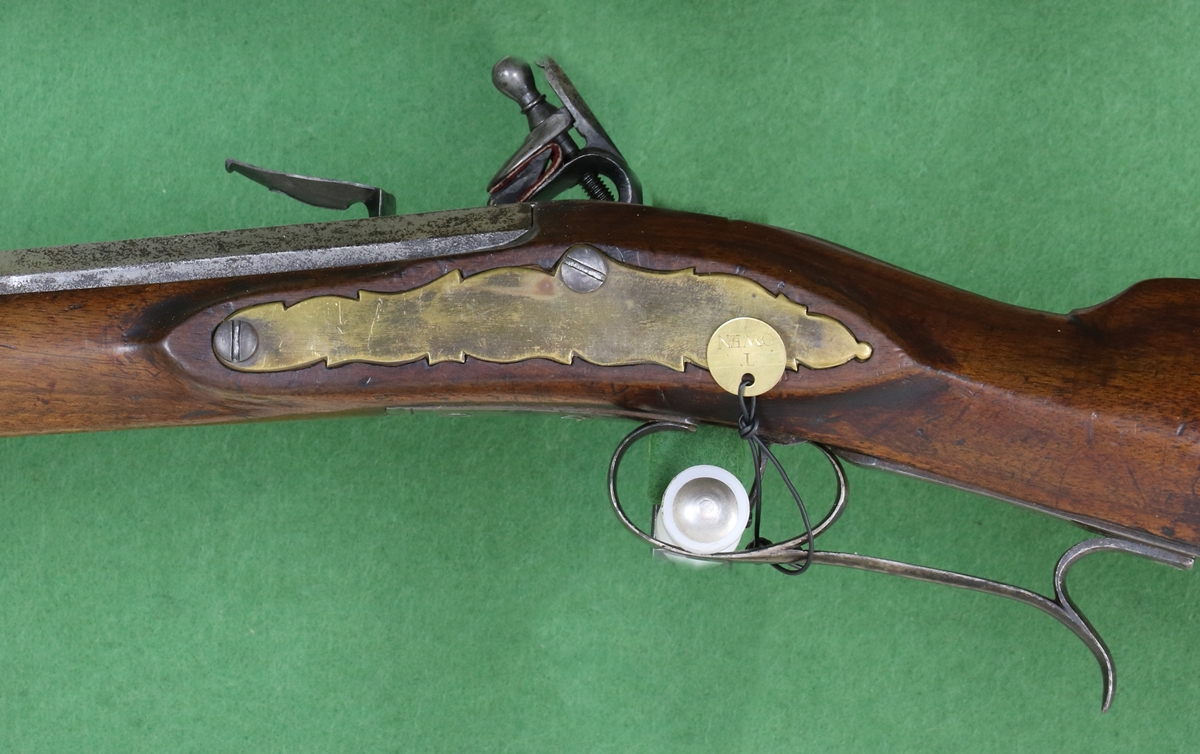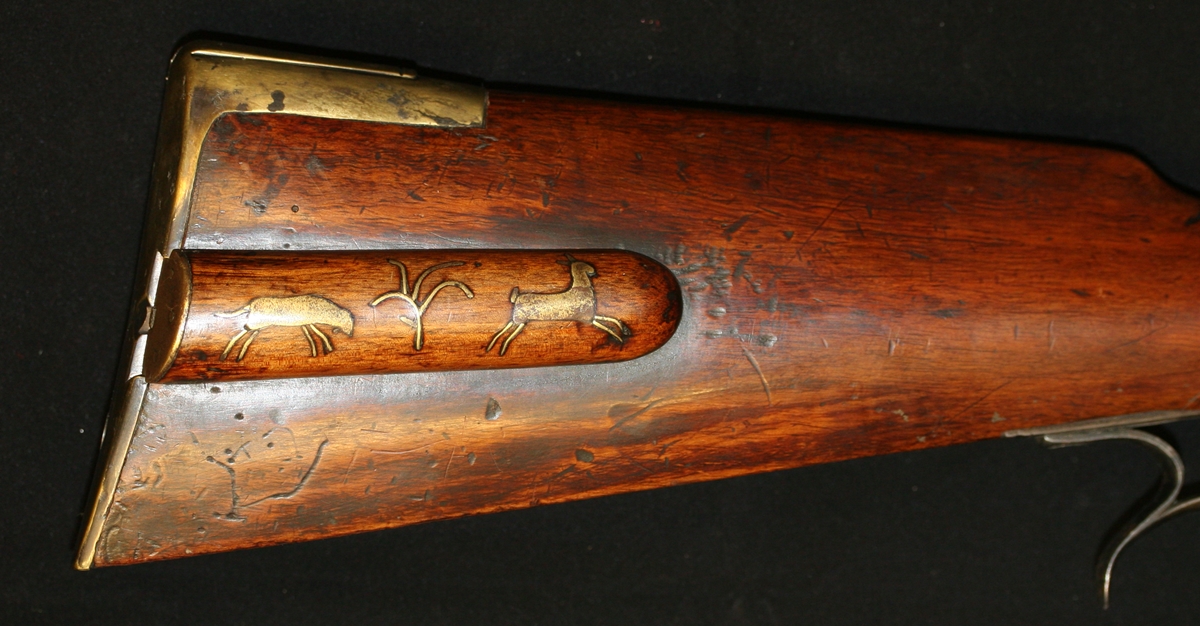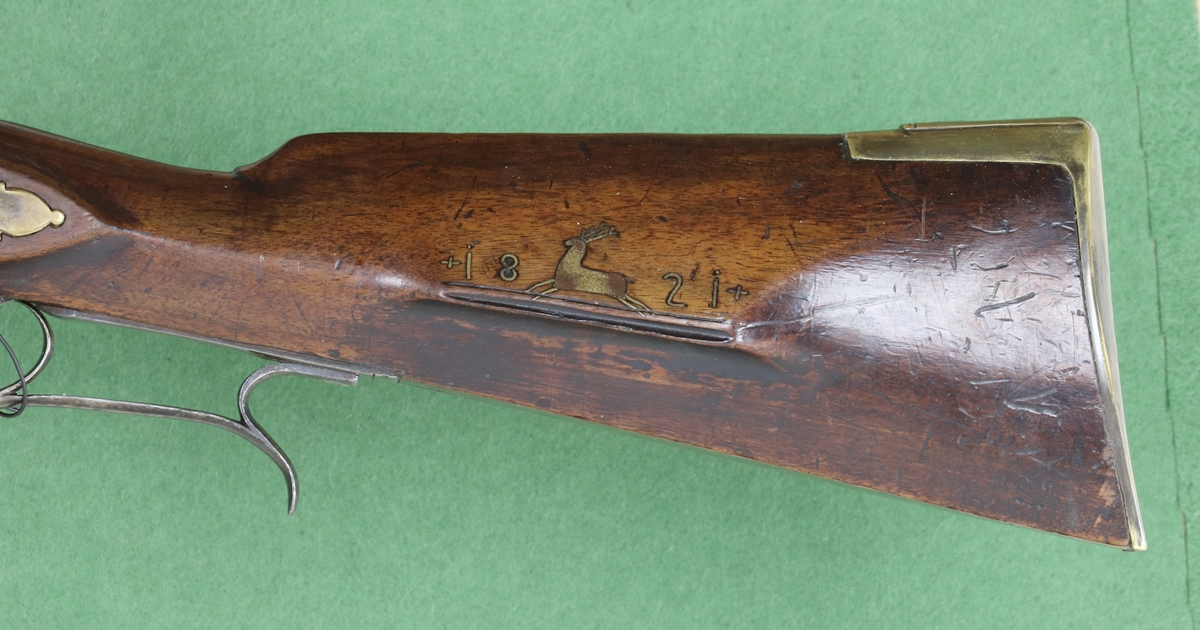Since I was playing with my new setup for photographing long guns I thought I’d post some pictures of my favourite gun ( my Westley Richards 12 1871 patent breechloader excepted!) , and one of my earlier restoration before I started this blog. It was a German (?) Jeager rifle I purchased from Holts for not much money( if I remember correctly- it now seems unlikely!) as a drum percussion conversion minus its trigger guard, sideplate and butt plate and in a rather sad state, but I was attracted by the inlaid brass figures and date on the stock. I kept the percussion lock intact and made a completely new lock with a casting for the detachable pan and a flintcock, frizzen and frizzen spring casting. The trigger guard was fabricated from strip metal and old bits, and the butt plate was modeled in lead and a silicone mould made and then cast in brass – all the casing done by Kevin Blackley. The side plate was filed from brass sheet, and new screws made. I’m very fond of the finished gun – its very simple and utilitarian, except for the delightfully naive inlay work. I’d like to imagine that this gun was one of the forerunners of the American Longrifle! ;-
You can see the ‘classic’ notch in the lock recess where someone cut away the wood to clear the sear arm as the gun wore!
New side plate in 1.5 mm brass
Isn’t that just perfect!
There isn’t that much left of the original gun – the stock, patchbox and ramrod pipes, barrel, trigger and inner lock parts, but it preserves the strong and unusual character of the original.





Hi Rick, Tim,
The maker’s barrel inscription is not totally readable in the photo but I believe I can clearly discern that it finishes with ” WEIMAR” . This was/is a German state and that tends to reinforce the impression created by the overall appearance and especially the heavy trigger guard (is it wooden?) that it is German made.
A thought which comes to mind with respect to the lock inscription – could the inclusion of the word “patent” be acknowledgement by the maker that the lock is to the Manton design but is not directly claiming to be made by Manton?
Regards,
Rod
Hi, Its a dead cert for a German rifle – The lock is not a conversion from a flintlock, but has the very distinctive continental curved shape around the nipple mount. It is a well made lock and the insides are fairly standard for a good lock by a maker of reasonable quality. I’m sure the John Manton Patent name is spurious – it was quite common to put spurious names on locks – although on a gun of this quality I can’t see why it would have been necessary, particularly with the barrel name followed by the city. That suggests it might be a later replacement? John Manton had become John Manton & Son before the introduction of percussion arms. The lock engraving would be a bit unusual on an English lock. Always fun to speculate on oddities, and a close up inspection might unravel the mystery, but a nice fancy rifle.
Tim
Hi Tim,
I found your site when searching for re-installing the mainspring on an old Manton lock that was installed in a percussion Jeager Style rifle. I am doing research for a friend who owns the rifle and pulled the lock to attempt to get a better idea of it’s origin and date of production. Also attempting to get an idea of its value as it’s a combination of a early 1800’s John Manton lock, old Germanic Stock, carving and engraving and the Barrel appears to also be germanic. The Carvings are exquisite as there is a dogs head on the forearm and other unique details. I’ve posted it on two message board sites to gather information and after opening the lock as requested an estimated value and also to get more info the communications has stopped. ?? not sure why so have started to search for someone such as yourself who is specifically fluent in these old gems.
First let me say I am a Luthier and Engineer and have a good shop and have built and repaired many detailed items but these old guns are new to me.
As I was removing the Lock there was a twisting pressure on the plate/lock and I put it at half cock and it seemed to help. Once I removed it the spring sprung off the lock and it was out. Fortunately now damage and all intact. After photographing it and understanding the mechanism I am ready to re-install the lock however am concerned about the way it popped out. I am using a fine needle nose pair of vise grip pliers as I do not have a spring vise. They work fine. My concern is it has no anchor for the mortise to set in and just sits on a ledge. I also see a hole in the side lock that had NO screw or pin in it and was wondering if this might be an installation pin hole that once a pin was placed and spring set it was removed once the lock was in place? Just a thought. I haven’t tried to set it in yet as I don’t want another explosive spring in my face, but perhaps once set it will be fine. Also not being my gun I’m very careful.
Hope this finds you well and thanks in advance for any help you can give me. (I’m also located in Spokane, WA in the US so I do realize that there may be a time zone dif)
Rick
Here is my DropBox link of photos… hopefully you can view these.
https://www.dropbox.com/sh/1hzhh92ggz5o87k/AADjFz3X-RrKpAICxeYmI_wPa?dl=0
I’ll give you a link here to see if you can view the message boards photos that I’ve posted and comments made and then let me know what your thoughts are.
Not sure if you are a member of these but you can view as a guest.
GunBoards Forum:
https://forums.gunboards.com/showthread.php?1150141-Help-id-Dog-Head-Percussion
Muzzleloading forum:
https://www.muzzleloadingforum.com/threads/help-id-dog-head-rifle.121337/
hi Rick,
I’d hazard a guess that the lock has never been near a Manton! it is of a distintly continental pattern with the ‘cup’ for the nipple swell. Also the signature on the lock is like nothing I’ve ever seen on a Manton – they were never to my knowledge in script,, Alwys block letters. Having said that it is a splendid piece and well made in the German (possibly French??) style. I’d guess the spring is a later replacement and maybe is not quite the right shape for the top arm to find the small groove that normally locates it. It may be difficult to see the recess if it is filled with oil etc. It doesnt seem to have a proof mark? I wonder if it was a high quality Leige gun for the German market? Anyway a very nice piece to have. The lock needs taking to pieces and gently cleaning ( see my You tube video on stripping a lock) to prevent more rust, bu otherwise its in great condition.
Tim